Mythbusting: 5 Myths About How Java Got Better

Java was originally designed for interactive TV, but at the time it was too technologically advanced for the cable industry. Java's history has teams called Green Teams, who initiated the project to develop digital devices such as set-top boxes, televisions, etc. However, its language started to be suitable for Internet programming. Later, Java was merged by Netscape.
The main reason for creating Java is simple: we need a language that is powerful, portable, platform-independent, safe, high-performance, multithreaded, architecture-neutral, object-oriented, interpreted, and dynamic.
In this fast, competitive world, Java programming development has reached a new level, and Java has evolved over the years. With the advent of AI and ML, Java has turned its focus toward security, secure transactions, and become a real tool for enterprise networks.
Has Java changed?
A lot has changed in the Java ecosystem in the last year. Oracle's management has delivered enhancements for continued platform integrity, and Mark Reinhold's keynote at Oracle Code One made it clear that Java is still open and free.
Mark Reinhold, Chief Architect of Oracle's Java Platform, assures loyal customers that Java is better than ever, with an active community and complete parity between commercial and open-source JDKs ( Java Development Kits ). Mark Reinhold said: "Don't worry - Java is still free."
A letter to Java from Matthew McCullough, VP of Field Services, proving the adage "When web companies grow, they become Java stores," Reinhold took to the stage to show off its new capabilities.
Three major changes of the year
"We're splitting the 23-year-old platform into 26 standard modules," Reinhold said. To help developers move their platforms faster in areas relevant to Java developers, the Corba and Java Enterprise Edition (EE) modules that were part of the Java Standard Edition were removed. Finally, Reinhold broke his silence and explained how replacing the multi-year release model with the fast six-month cadence announced last year would benefit Java developers.
If engagement is a healthy measure, then JDK 11 is booming. "JDK 11 has the most external contributions of any release we've seen," Reinhold said.
Five myths about Java
Mark Reinhold addresses the top five misconceptions (also known as fear, uncertainty, and doubt, or FUD) about the new Java release model:
Feature releases will break past releases - not really. "The speed of innovation has not changed, the speed of innovation distribution is changing," said Mark Reinhold.
To remove old features, they must be deprecated three years in advance. "Incorrect, in order to remove deprecated features, it requires a production-ready build with appropriate warnings at compile time or runtime, since a working build is the final release method after all."
Your support will end for any non-LTS release six months after the LTS release and up to three years later. "That's not true; it's up to non-Oracle members of the JDK community to decide what to do. Oracle has a solid track record and is already discussing how best to support JDK 8 and JDK 11 long-term."
Non-Long Term Support releases are just another name for beta releases. "No, the only difference with the LTS version is that it has a longer support timeline," Reinhold said. "You can still use the non-LTS version in production if you want, but you have to update it within six months or Find someone to support or support yourself.”
If you maintain an uncommon migration system, you can ignore non-LTS releases, "Reinhold claims this isn't true either, claims", if you test with every feature release, you're ready to migrate to the next long-term support Version".
How do you feel about the new release cycle? Let us know in the comments below!
In addition, I have been engaged in online education for many years, and I have integrated my information to build a public account. If you are interested in exchanging and learning java, you can search on WeChat: "Programmer Civilization", there will be a great god who will give answers, and there will be many resources available for Everyone is learning and share, and everyone is welcome to come and learn and progress together!
Related Articles:
Can This Be a Possible End to the Functional Programming Debate?
The debate regarding which is better—.NET or Java keeps getting a new dimension every time someone poses a question. While there are developers who are familiar with both sides and use each loyally, there are some who are well-aware of each’s advantage and would not mind making a choice when it comes to availing the benefits of the best features that these offers.
While there is no perfect “yes” or “no” answer to the question regarding, which is better, there is a possibility of just listing down which one what betters. A definite answer would require considering multiple facets which might be too much to do. However, listing the pros and cons is easy and would not require much information.

Functional Programming
Functional programming in developing refers to creating structures that would come together to form computer Software. It makes use of functions that are written in programming languages of choice. While some developers prefer focused languages like Lisp, others prefer universal options like Java and .NET.
Java vs. .NET for Functional Programming
Developers who are experts in functional programming look for a few things when deciding the functional language. Modularity and compensability remain on the top of the list for all functional developments. The prime aspects remain to be support for Lambda and also integration. These are the factors that we will analyze to decide which is better.
The first important aspect to consider is that Java 8 supports Project Coin and Lambda which adds a feather in the cap for Java as a functional language. Considering functional programming as a mathematical equation and focusing the programming on balancing the equation is the core of functional programming.
In .NET, the developers have to look for options and use either C# or F# to make use of the lambda functions. This in itself is a dilemma for developers in the beginning and might be considered a downside for .NET. The Java 8 has made immense improvements in terms of the expressions and functions and if you had ever given Java a try for the functional programming before and given up. Try it once more and this time, you would not regret it.
In terms of the micro-services, .NET has an upper hand. Developers unanimously agree that integration is better in .NET in comparison to Java. This, however, does not imply that Java is bad with respect to integration. The benefit that .NET developers get because of compatibility with Azure takes the integration experience to the next level which is what all programmers desire.
The Verdict
In my opinion, Java wins the battle here because it is slightly more advanced in terms of features and compatibility features. Depending on the end expectations of the Software that you are developing, a Professional Java outsourcing company is more likely to be versatile in comparison to .NET which has limited advantages over Java. Let us know which functional language are you likely to choose and why in the comments section below.
Related Articles:
How To Integrate Spring With JPA Hibernate In Java Development
Programmers And Developers Need To Wait More For Java 9
As the officials failed to meet expectations for the planned release of Java 9 in September 2016, java programmers and the development community will have to wait for more than six months. Despite good progress in the Jigsaw project, the modularization standard for Java9 is still in process and won’t be released with the scheduled 10 December JDK9 milestone. Let us clear that Jigsaw is not a “feature complete” and this is the reason why officials have postponed the release date of Java 9 by six months.

Jigsaw Needs More Time
Jigsaw is the main feature of java 9 and it needs more time to ensure that the maintainers of essential build tools and IDEs have ample time to design and implement great support for modular development. And to make it happen, officials need an extension of 6 months.
The chief officials of the Java platform group have blamed the delay on complexities in intending modularization that enhances performance and scalability. However, they have ensured the community that they have made good progress on Jigsaw for 18 months, but it needs more time.
With project Jigsaw, java programming will be extended to have a concept of modules. Officials want to make modules a regular tool in a developer’s box to organize the code. Modules can be combined into several configurations in all phases of web application development, including build time, compile time, run time, or install time.
Declaration And Resolution
A module will declare which other modules will be required to compile and run dependencies. The module system will use it to transitively identify all the modules needed to compile or run the initial resolution.
Versioning modules support will be available. Jigsaw will not support multiple versions of a module inside a single configuration. If it is true, then how does this solve JAR? The module system might also not employ version selection.
The performance will get evolve with Jigsaw. Within a module system, it will be easier to automate reasons for all the places where a certain code will be used.
Java programmers need to wait for June 2016 as officials will release Java 9 along with the Jigsaw update.
Do you think that Java 9 is worth waiting for? Drop your comments and share what you feel about it. Let us know if we have skipped any important information.
Related Articles:
How the upcoming Java Update would make Yahoo as your default search engine
What Is The Use Of Waratek JVM In Java Web Development?
HOW TO CREATE A PAGE USING TEMPLATE IN AEM WITH JAVA?
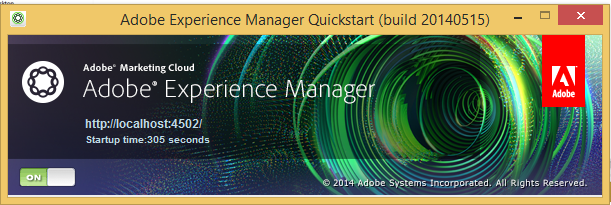
Do you know AEM? It is a content management tool used by Java application development India teams to generate websites, apps, and mobile platforms. In this post, the teams will build you learn about the steps to generate a page using the template in AEM.
Technology:
AEM(Adobe CQ5), stands for Adobe Experience Manager. It is a Content Management Tool that is used to create a website, mobile platforms, and apps. It is easy to manage the content and assets of your website with AEM. It is a large-scale web content management system that is currently available in Adobe Systems. The Server of AEM is platform-independent as it is based on java technology.
Usecase:
We can create a template in AEM which will be useful for creating pages for a website. A Template is used to create a page for the website and define which components can be used within the defined selected scope. A template is a hierarchy of nodes that has the same construction as the page to be created but without any real content.
There are 5 steps to creating the page:
- Start the AEM Server.
- Open crxde lite in server.
- Create the template.
- Create a page component
- Create a page using that template.
- Activate the page.
Step1: Start the AEM Server:
To start the AEM server double click on the jar file.
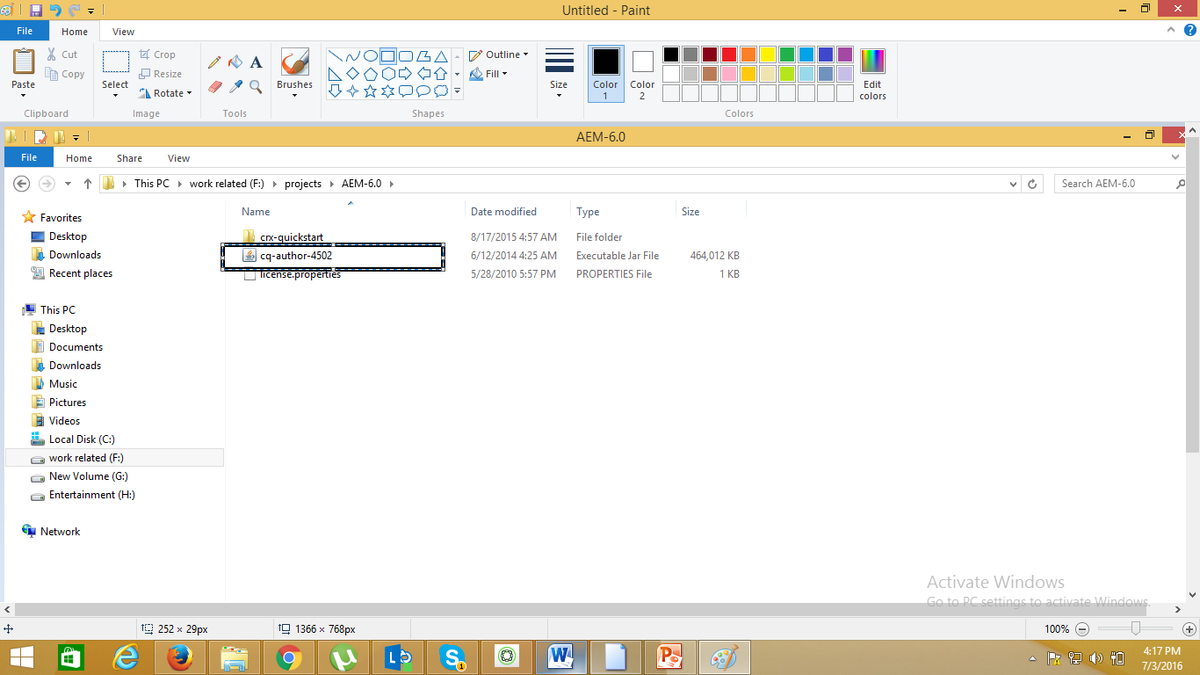
Once AEM started, it look like below
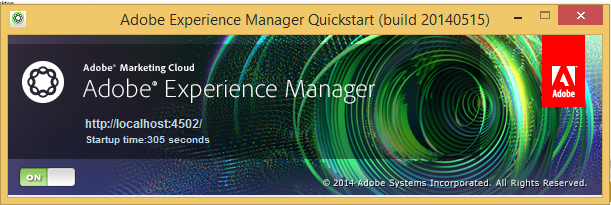
Once the server started, by default a window will open in the

Provide the credentials,
Username: admin, password: admin
Once you successfully log in, the below screen will come up.
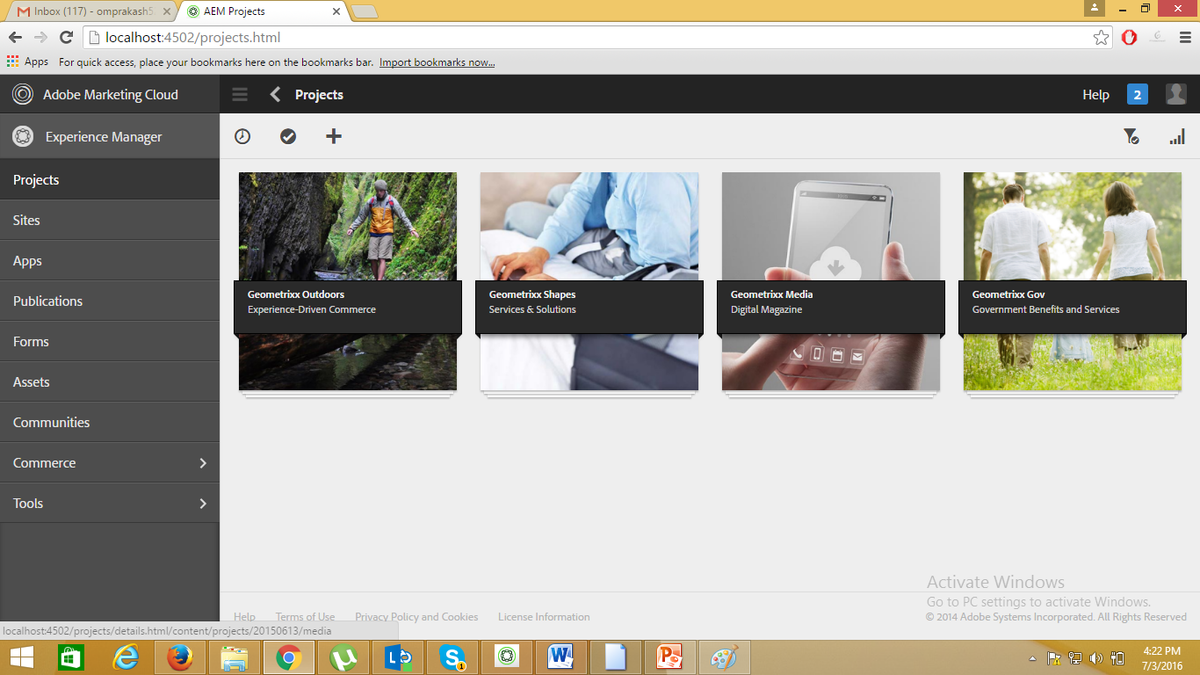
Step2: Open CRXDE lite.
Click on Tools,
If the user clicks on Add Image button, a pop-up dialog will open to select the image…
The code snippet to select the image will be below:
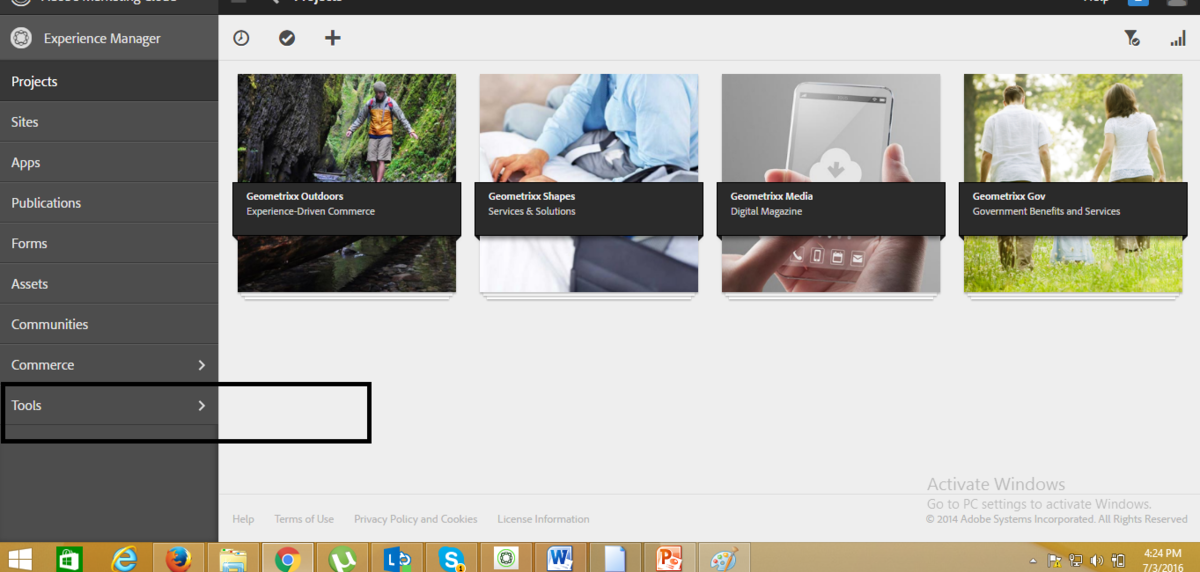
If you observe user has the possibility to filter the images based on the type like jpg, .bmp, .gif, etc.
FileDialog is a framework class to deal with file-related stuff.
Step2: How to Open CRXDE Lite
Click on Tools,
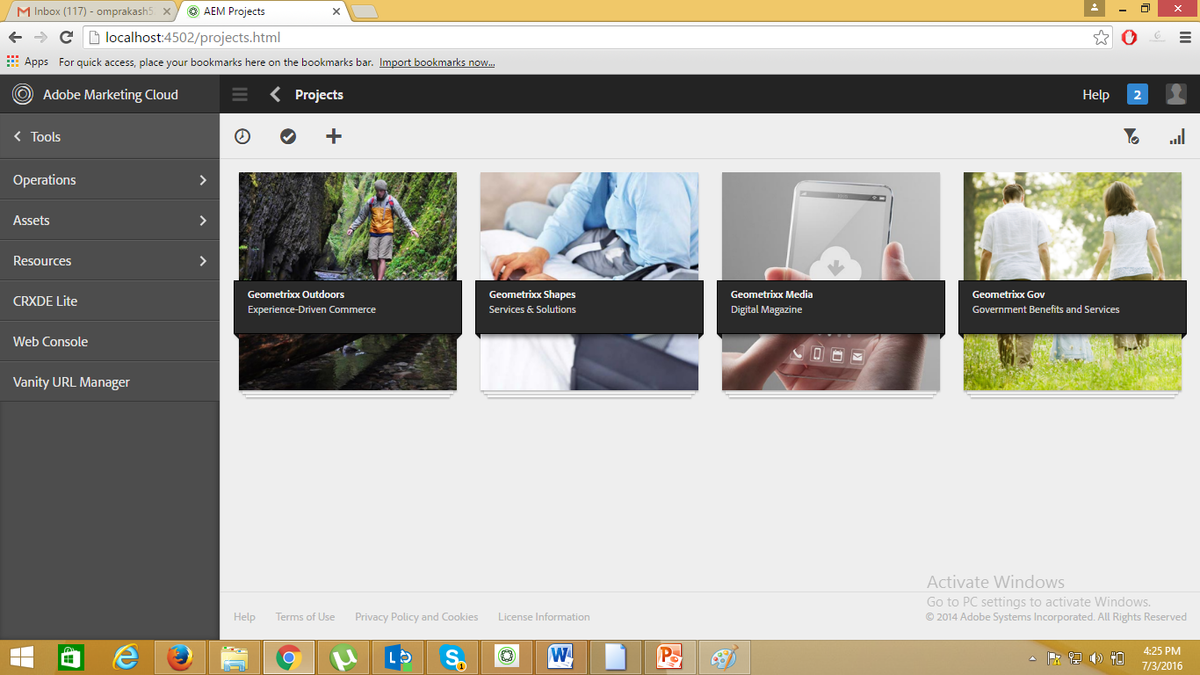
Then click on CRXDE Lite,
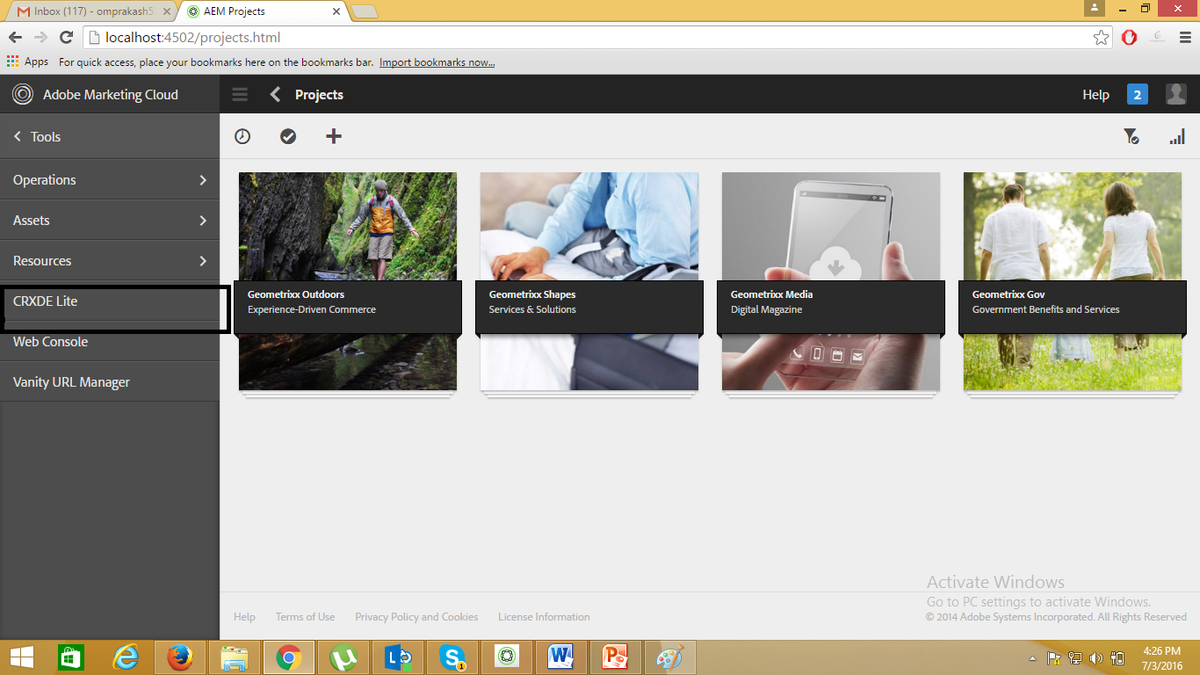
CRXDE Lite Console,

Step 3: Create a Template
To create a template, Right-click on the template folder and select the option create the template
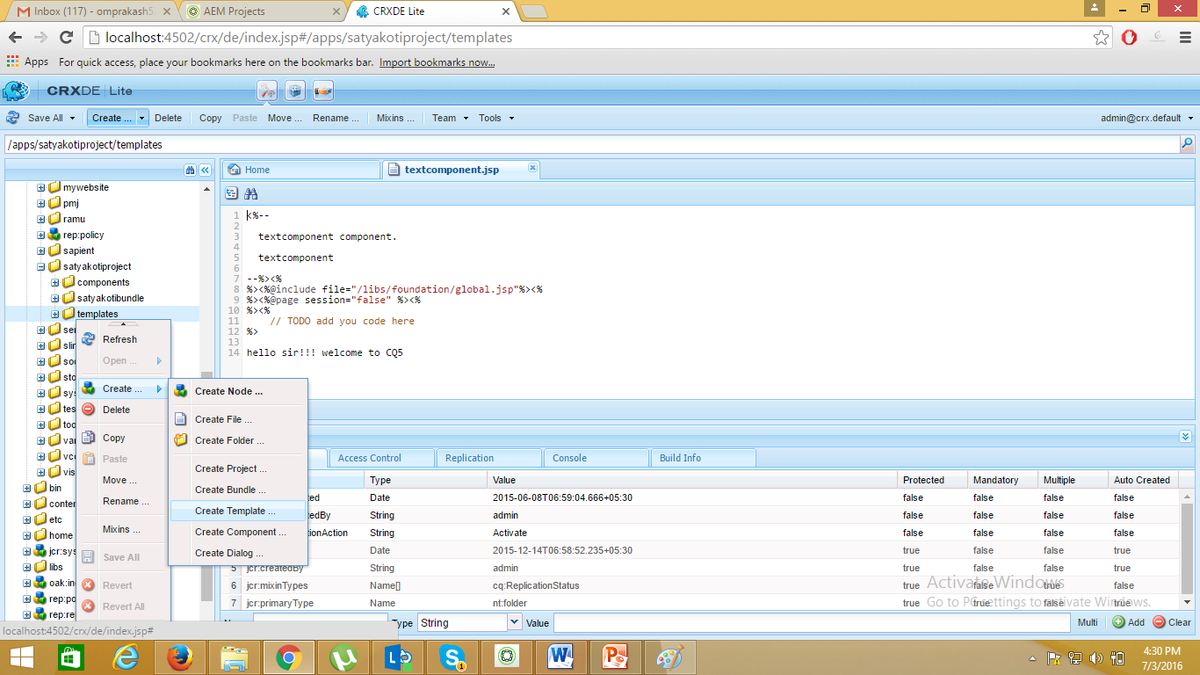
Then provide the template information like label, title, description, resourceType(mandatory),
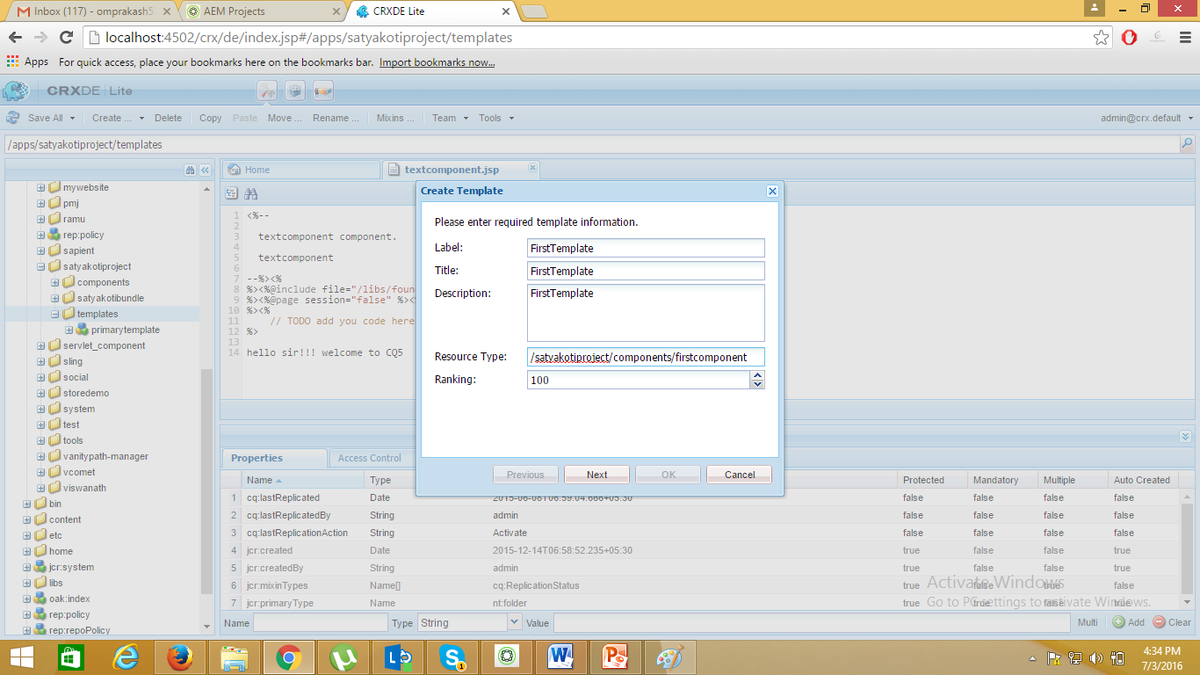
Step 4: Create a Page Component
To create a component, right-click on the component folder and select the create component.
Provide the component(first component) information like title, label, description(mandatory). resourceSuperType is not mandatory.
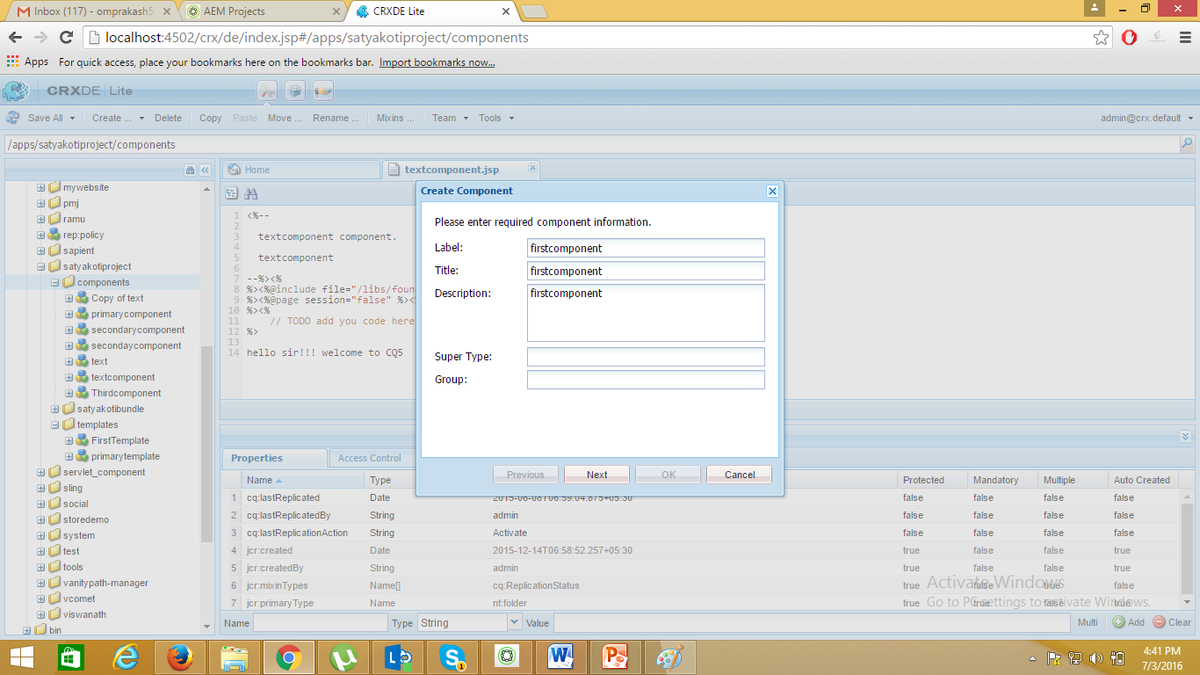
With component, you will get a jsp file with component name first component.jsp. open the jsp file and write the script whatever you want to show it on page the

Step 5: Create a page using the template
Open siteadmin, with urllocalhost:4502/siteadmin

Click on new,

Select the title first page and select the template FirstTemplate
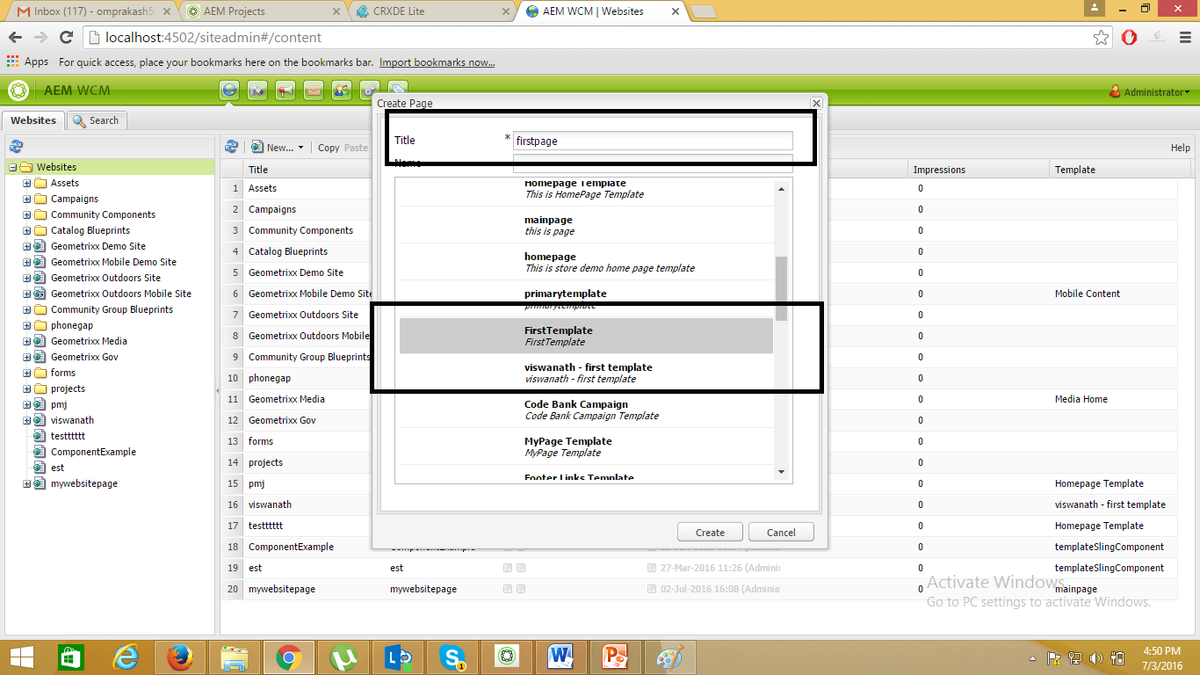
Step 6: Activate a page
Right-click on the page and choose the option to activate,

You now know the basics of AEM. Hope the java application development India team has made you understand the process of creating a page using the template in AEM. Still, if you feel confused about any part of the post, ask the team.
HOW TO USE SPRING FACTORY BEANS IN JAVA DEVELOPMENT

Technology: Spring is the popular framework for java developing applications in an easier way by providing various utility classes. In this post, java outsourcing company experts will explain Spring Factory beans brief. Let’s get an overview of the spring container that offers two methods to create beans. We will also discuss these two methods – beans and factory beans.
Overview: Spring Container provides two ways to create beans, one is default beans by writing xml file or with Java annotations, second is the factory beans.
Spring Factory beans provide plug ability to Spring IOC Container`s bean initialization. If we need complex code to initialize the bean or if we have more no of dependencies then instead of writing large XML we can create a custom factory class and we can plug it into Spring Container.
Factory Beans are mostly used to help spring containers in constructing beans that couldn`t be easily constructed by themselves.
Example: suppose if we want to get the object from JNDI, we can use JNDIFactoryBean so that a reference to bean is created on loading time, whenever is needed we can invoke the getObject() method on factory bean which will return the actual bean reference.
Understanding about Factory Beans:
Spring provides a FactoryBean interface for creating factory beans.
Public interface FactoryBean<T> {
T getObject() throws Exception;
Class<?>getObjectType();
booleanisSingleton();
}
Let`s understand about methods:
getObject(): this is the main method to return an actual instance of the class, it may be the same instance or a different instance based on implementation, as the spring factory supports both singleton, and prototype design patterns. Before Spring 2.0 while calling the getObject method if the factory bean is not fully initialized (depending on other beans, or circular dependencies) it uses to throw FactoryBeanNotInitializedException exception, but after spring 2.0 if the factory bean is not loaded fully then it will return null, but it is encouraging to throw FactoryBeanNotInitializedException exception if factorybean is not initialized.
getObjectType(): this method will return what type of object that factorybean will create. It will be used in auto wiring of the beans without instantiating it. It may be called before fully initializing the factorybean, it may not depend on the state of the factory bean.
isSingleton(): this is the method that will tell the spring container, the factory bean will return the same instance of the object every time we call getObject() or a different instance of an object.
If this method returns true then the spring container will cache the instance of the bean without invoking the getObject() method every time.
If this method returns false then the spring container will execute getObject() every time, as we call the getObject() method.
Creating beans using Spring Factory Bean interface:
We can create beans in two ways.
- We can implement the FactoryBean interface.
- Spring provides an abstract implementation of the interface, by extending the class we can write the factorybeans. We need to override the createInstance() method to create the instance and getObjectType() method to tell the return type to the spring container for auto wiring.
If the instance provided by factorybean is singleton then it will return the object instance, otherwise, it will return a proxy of the getObjectType() type of the object.
Some of the existing implementations of spring factory beans:
- JndiObjectFactoryBean: for creating beans depending upon JNDI lookup
- ProxyFactoryBean: creating beans depends on Spring AOP pointcuts
- LocalSessionFactoryBean: for creating Hibernate session factory in Spring IOC Container.
Writing custom Bean factories:
We will implement StudentFactoryBean to produce objects of the type Student.
Student.java
public class Student {
private String firstName;
private String lastName;
private String email;
public Student(String email) {
this.email = email;
}
// getters and setters
}
StudentFactory.java
public class StudentFactory extends AbstractFactoryBean<Student> {
private String email;
//setters and getters
@Override
public Class<?>getObjectType() {
returnStudent.class;
}
@Override
protected Student createInstance() throws Exception {
return new Student(email);
}
@Override
publicbooleanisSingleton() {
return false;
}
}
StudentFactory is the factory bean that will return student objects.
XML Configuration: lets create a spring beans xml file (student-factory-beans.xml) and add the below bean declaration.
<bean id="student" class="com.example.StudentFactory">
<property name="email" value="test@gmail.com"/>
</bean>
Testing injected Student object:
@RunWith(SpringJUnit4ClassRunner.class)
@ContextConfiguration(locations = { "classpath:spring-factory-beans.xml" })
publicclassStudentFactoryXmlTest {
@Autowired
private Student student;
@Test
publicvoidtestConstructWorkerByXml() {
assertThat(student.getEmail(),
equalTo("test@gmail.com"));
}
}
The above test confirms that the student object was injected correctly using StudentFactorygetObject() method.
Accessing FactoryBean instance:
We can inject the factoryBean instance using by adding “&” before the bean name.
Testing Student object injection using factoryBean injection:
@RunWith(SpringJUnit4ClassRunner.class)
@ContextConfiguration(locations = { "classpath:spring-factory-beans.xml" })
publicclassStudentFactoryBeanXmlTest {
@Resource(name="&student") privateStudentFactorystudentFactory;
@Test
publicvoidtestConstructWorkerByXml() throws Exception { assertThat(studentFactory.getObject().getEmail(), equalTo("test@gmail.com"));
}
}
Creating Factory Beans using Java Annotations:
We can create a configuration class using @Configuration annotation, and we can specify the class in @ContextConfiguration using the classes attribute.
Creating configuration class:
@Configuration
publicclassStudentBeanConfig {
@Bean(name="student") publicStudentFactorygetStudentFactory()
{
StudentFactorystudentFactory = newStudentFactory();
studentFactory.setEmail("test@gmail.com"); returnstudentFactory;
}
}
And test class for Java annotation style:
@RunWith(SpringJUnit4ClassRunner.class)
@ContextConfiguration(classes = StudentBeanConfig.class)
publicclassStudentFactoryJavaTest {
@Autowired
private Student student;
@Test
publicvoidtestConstructWorkerByXml() { assertThat(student.getEmail(), equalTo("test@gmail.com")); }
}
Read More: What to Keep In Mind When Hiring Java Developers and Outsourcing Services?
The above test confirms that the Student object was injected correctly.
We can also inject the factoryBean instance using Java Annotation style similar to XML configuration.
@RunWith(SpringJUnit4ClassRunner.class)
@ContextConfiguration(classes=StudentBeanConfig.class)
publicclassStudentFactoryBeanJavaTest {
@Resource(name="&student") privateStudentFactorystudentFactory;
@Test
publicvoidtestConstructWorkerByXml() throws Exception {
assertThat(studentFactory.getObject().getEmail(), equalTo("test@gmail.com"));
}
}
The above confirms that studentFactory Bean injecting successfully using “&” before the bean name.
Sometimes we need to do some operations before calling the getObject() method then we can use the InitializingBean interface, and implement the afterPropertiesSet() method or we can use @PostConstruct annotation on the operation implemented method so that it will be called on start-up.
Conclusion: we can use factoryBean for the complex scenarios for creating bean instances, we can either use xml configuration or annotation style. If the bean is of the type factoryBean then the spring IOC Container will call getObject() method on the instance for creating bean instances.
We can implement Initializing Bean interface or @PostConstruct annotation if we want to do some operations before calling the getObject() method to return the bean instance. FactoryBean also supports singleton and factory bean scoped bean instances.
You can follow the instructions shared by java outsourcing company experts here in this post and know the Factory Beans. If you have any questions, you may write in comments and wait for experts to respond to you.
Template Method for Java Development – Tutorial Alert
You will get an idea from the fundamental Template technique from Java development India-based experts in this story. The code example used by developers is for reference purposes only. You will learn how Template Method builds the code more recyclable and stop duplicating the code. Read further for more information.
Introduction
In Java, to build the code more authentic we should plan our code accurately that can be done by applying plan methodologies such as OOPs, OOAD, design principles, and patterns into applications.
GOF says that – “Describe the skeleton of an algorithm in a technique, deferring some steps to subclasses. Template Technique lets subclasses reconsider certain steps of an algorithm without changing the construction of the algorithm”.

Template Technique is an observable design that is used where there are two or more same behavior or execution that obtain for an algorithm.
A real-world template technique is appropriate in all places,
For example,
- Playing a video game always has the steps – 1. Init, 2. Play, 3. Crash but the games can be Changed like cricket, football, volleyball, etc.,
- Transporting things at all times has the steps – 1. Init or Place Order 2. Load 3. Tracking 3. Deliver but the transports can be changed like torus, tailor (vary in load capacity and speed)
- Establishing a building or house always has the steps – 1. Design 2. Build Base 3. Make Pillars 4. Construct wall 5. Furnish but the construction can be changed by design, base, pillars, and wall (brick wall or glass wall or wood wall).
In such a structure, we can have a particular algorithm like Building which may have the steps – 1. Design 2. Build Base 3. Make Pillars 4. Construct wall 5. Furnish and the subclasses that are dissimilar kinds of construct Office, Hotel, Shopping Mall, Temple, House, etc. which will take care of all step but will follow the same algorithm
e.g.
|
public abstract class Building { // template method // a final method contains all the steps to be executed in an algorithm public final construct() { design(); buildBase(); makePillars(); constructWall(); furnish(); } // steps are declared as abstract methods and the behaviour will be implemented in sub classes protected abstract void design(); protected abstract void buildBase(); protected abstract void makePillars (); protected abstract void constructWall(); protected abstract void furnish(); } |
|
// Office is a building that may vary in design, base, pillars, wall, and furnishing and it will be implemented or overridden as required for an office public class Office extends Building { protected abstract void design() { // design for office (official) } protected abstract void buildBase() { // base for office } protected abstract void makePillars() { // pillars for office } protected abstract void constructWall() { // wall for office (glass walls may be) } protected abstract void furnish() { // furnishing for office } } |
|
// Hotel is a building that may vary in design, base, pillars, wall, and furnishing and it will be implemented or overridden as required for a hotel public class Hotel extends Building { protected abstract void design() { // design for hotel (commercial) } protected abstract void buildBase() { // base for hotel } protected abstract void makePillars() { // pillars for hotel } protected abstract void constructWall() { // wall for hotel } protected abstract void furnish() { // furnishing for hotel } } |
|
// House is a building that may vary in design, base, pillars, wall, and furnishing and it will be implemented or overridden as required for a house public class House extends Building { protected abstract void design() { // design for house (personal) } protected abstract void buildBase() { // base for house } protected abstract void makePillars() { // pillars for house } protected abstract void constructWall() { // wall for house } protected abstract void furnish() { // furnishing for house } } |
Read Also: Be prepared for the Li-Fi technology 100 times faster than traditional Wi-Fi
|
public class Client { public static void main(String aa[]) { //construct hotel Hotel hotel = new Hotel(); hotel.construct(); //construct office Office office = new Office(); office.construct(); //construct house House house = new House(); house.construct(); } } |
Conclusion
Just assume that if we didn’t use the template technique how would we build these hotels, houses, and offices? On all class hotels, houses and offices we would create a duplicate technique called construct!!
Template Technique builds our code more reusable and it actually avoids copying the code. So do apply template technique pattern wherever the structure (where two or more behaviors exist for an algorithm) appears. For doubts or queries, make comments below.
Author Bio:
This tutorial is created and shared by Ethan Millar who is a Java development India-based experts tow writes technical articles. This post is to make you learn about the Template Method. You can use this method and make your code more reusable and prevent duplication of code just like professionals.
Java Development – Why Outsourcing to Offshore Development Companies Is Beneficial?
Nothing new for outsourcing it is a job in the IT industry. It is a process in which a company’s business is delegated to an external agency or a third-party company for leveraging financial and various other benefits.
Sometimes the department is outsourced, while there are times when a part of the job is allocated to a third-party company. The third-party vendor is usually located in another country, mostly a developing nation.
Whether it is Java development outsourcing or other technologies involved, any business organization can avail outsourcing facilities irrespective of its size. Check out the following points which describe why outsourcing has become a common rule for many organizations nowadays.

Ability To Focus On Core Business
The main reason behind outsourcing work to different agencies is to focus on the core business in a proper way. Usually, jobs that are time-consuming, as well as mundane, are delegated to vendor companies. Accordingly, result, the business owner is able to focus on the main areas of the business and make bigger decisions to meet business aims.
Looking For Innovation In The Work
It is interesting to note that many businesses outsource development works to offshore companies as they look for innovation in the work. The vendor companies have a target of meeting the clients’ satisfaction to the highest level and put their best effort to find creative ways to better present their work to the clients.
Reaping The Benefit Of Different Time Zones
While assigning a software development job to a third-party vendor, the geographical location of the organization is a key factor. If it is an offshore company, it is likely that they are part of a unique time zone that is generally 8-10 hours ahead. This means that you get business on a round-the-clock basis. The variance in time zones leads to increased productivity.
Also Read: Java 9 Features That Will Change Your Way To Develop Software Solution
Skilled Workforce
This is one of the greatest advantages of endowing the responsibility of development work on a vendor company. Whether you are looking for a Java web application, standalone software system, or mobile app, you get the service from some of the best professionals at a lower cost. Some developers work on a monthly payment basis, some work on fixed, project-based rates while some charge hourly payments. The payment mode which seems most fit can be selected by the main business company.
Greater Efficiency With Reduced Costs
Turn down cost is surely another reason which forces companies to outsource their projects to offshore organizations. In developing countries, it is possible to get the development work done in an extremely efficient manner but at a much lower cost. From a competitive edge, this is definitely beneficial for the main business company.
Better Risk Management With Great Backup
When the job of java application development is delegated to an offshore vendor company, the responsibility of project risk management is to be handled by the company. In fact, if any kind of backup or post-development service is required, the vendor company arranges for the same.
With offshore development service suppliers available, it is essential to select the proper vendor for all your IT outsourcing necessity. Check the status and work samples of the organization before providing critical projects to them.